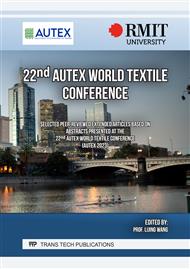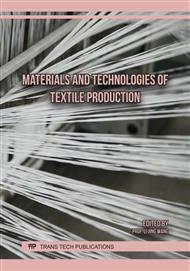p.17
p.23
p.29
p.37
p.47
p.55
p.63
p.73
p.81
Comfort Properties and Antimicrobial Activity of Cotton and Nylon/PU Knits Treated with Microcapsules Containing Sea Buckthorn Oil
Abstract:
This study was performed to investigate comfort properties and antimicrobial activity of cotton and nylon knits treated with microcapsules containing sea buckthorn fruit oil reported as having antimicrobial efficacy depending on concentration of microcapsules and treatment types. Chitosan-arabic gum microcapsules containing sea buckthorn fruit oil were prepared and they were treated on cotton and nylon/PU knit respectively by an experimental design of 2 different treatment types (bath immersion method and screen printing method) Χ 5 different concentration levels of microcapsules (20, 30, 40, 50, and 60% on the weight of fabric). As comfort properties, stiffness, water-vapor permeability, and air permeability were measured objectively. Antimicrobial activity was evaluated by calculating the percentage reduction of the bacterium. As results, stiffness values of the treated knits were slightly higher than those of untreated ones, which was thought not to affect touch in wear. The values of water-vapor permeability and air permeability of both cotton and nylon after the treatment were not significantly decreased. These results means that microcapsules loaded on the knits might not worsen their wear comfort. As for antimicrobial activity, more than 90% of bacterial reduction rates against S. Aureus were shown in cotton jersey by screen printing even after repeated laundry while those was found in nylon/PU tricot by bath immersion. From these results, it was concluded that chitosan-arabic gum microcapsule containing sea buckthorn fruit oil could be utilized for textiles to provide antimicrobial activity.
Info:
Periodical:
Pages:
81-86
Citation:
Online since:
March 2024
Authors:
Price:
Сopyright:
© 2024 Trans Tech Publications Ltd. All Rights Reserved
Share:
Citation:



